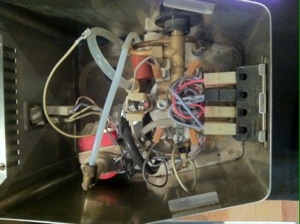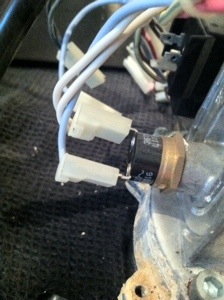So today I decided to do the thing that I’ve dreaded for a long time. Take my home machine completely apart, clean it, and put it back together. As mentioned in my previous post, I own a second hand Gaggia Classic, it’s only been since I’ve owned the machine that I’ve learned about proper machine maintenance, and it’s only been recently, about a year after purchase that I’ve started to delve inside the machine and really started to take a look.
This is what saddened me when I looked inside….
What you see here is some form of limescale build up and corrosion. It’s not the worst you’ll ever see, but it’s certainly not the best. I thought this might be normal, you look into the bottom of your kettle and you may see something similar. It wasn’t until I had my Dad send his machine to me for me to look at, and I realised that his (which is considerably older) looks brand spanking new compared to mine.
It’s quite daunting when you first open up the top of an espresso machine, you’re met by wires, bolts, boilers, pumps, everything.
When I was younger I put together my own Computer from ‘scratch’ (motherboard, graphics card and the like). In all honesty this, like putting together a computer, is as easy as putting a toddlers Lego toy together. Let me remind you that these things are not computers, the wires don’t carry information, they simply carry power to the right places (it’s like drawing dot to dot) as long as you can remember how to count from 1-10, you can remember which way round to unplug and plug these back in again.
Everything else underneath the wires are simply nuts, bolts, screws, and thermostats.
Thermostats are basically what tells the boiler what temperature to get to before turning off. The Classic has two of these (one for the water/espresso, and one for the steam wand/milk). This is one thing you DO NOT want to mix up as the steamers thermostat is considerably hotter than the water, you’ll simply end up burning every single shot if you put them back the wrong way round. Luckily, mine had a red dot on one and not on the other, so I could remember which was which.
So here’s where I stopped taking photos as I wanted to concentrate with this being my first time. (I also had a cat walking around on the work surface, and another clawing at my feet throughout this process, you can imagine the language I started using). Before move on, say hello to Dodger and Lola (they aren’t ours, cat sitting for my partners sister)
So I proceeded to take apart the boiler, soak them in some cleaner, scrub them, and put them all back together again with some brand new seals, this being the reason I believe for the build up around the boiler (old seal causing a leak). Regardless of what I said earlier, I did plug a couple of things in the wrong way, but I managed to work out which ones were which and get it right. Home espresso has never tasted better.
So what’s my point to all of this? I know that this post has been hefty anyway, but imagine this. A coffee shop opens its doors, in the morning pulls an average of 50 shots per hour (dependant on customer intake), it’s open for 8 hours, so that’s around 400 shots. That machine will be back flushed and cleaned at the end of the day to get rid of the days coffee residue on the shower head etc. These machines are used so regularly that the machine is being constantly flushed through with new filtered water, home machines however are not so lucky. You may think “well I only use my machine for one or two drinks a day so why should I ever need to clean it like you have”. Well, the answer being what I’ve said. By only using it once or twice, you’re not flushing the system through like a busy cafe, you’re leaving water to go stale in the machine, coffee around the shower head with oils that will seep into every crack, maybe milk in the steam wand (hopefully not). If anything we need to be even more careful with home espresso machines, personally I find that after a couple weeks I can taste the dirt seeing into my espresso, I know then that it’s been way too long since I’ve done a proper back flush.
If you’ve invested in a machine, make sure you know how to clean and maintain it. I personally have started to make this a routine. Wiping the showerscreen, flushing through fresh water, and purging the steam wand after every use. Back flushing with clean water after each session. Back flushing with cleaner and soaking the Portafilter, basket, steam wand tip and showerscreen in cleaner each week. Using filtered water, and still descaling the machine regularly. Doing things like this will ensure that you get the best out of your machine, and all the money you invest into good quality coffee.
Take a look at some of these links for some useful information, and also for spare parts (mainly for Gaggia Classic) if you need them.
Ethan Zonca runs through taking apart a Gaggia Classic
Mark supplies some great advice and spare parts for a number of Gaggia products
Happy Donkey are great for cleaning products
Some great information from the Home Barista Forums on regular cleaning etc



